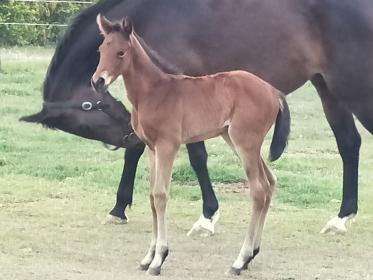Has anyone ever heard or experienced a recipient mare foaling the wrong horse. I had an et foal born this yr, a brown filly. My problem is her biological parents are both chestnuts! Is it possible the vets have mixed up mares/embryos or semen? Currently awaiting dna test to confirm if foal has any gentics of its supposed parents…
I’m so sorry to hear that.  Definitely, there is a mix-up somewhere as two chestnuts can only produce a chestnut foal. This isn’t the first time it has happened. Let us know when you get the DNA back. The facility that performed the embryo transfer should be compensating you in some way. Depending on what you do and how the facility handles it, it may be beneficial to seek the advice of an equine attorney in your home State or Province.
Definitely, there is a mix-up somewhere as two chestnuts can only produce a chestnut foal. This isn’t the first time it has happened. Let us know when you get the DNA back. The facility that performed the embryo transfer should be compensating you in some way. Depending on what you do and how the facility handles it, it may be beneficial to seek the advice of an equine attorney in your home State or Province.
Here is the old thread on another person who went through the same thing. https://www.chronofhorse.com/forum/f…date-july-2011
Could the foal just be a dark chestnut? My guy is a liver chestnut and was born very dark and has some black in his tail so he was actually registered as bay.
Yes you can get a brown from two chestnuts. The non-agouti pattern is recessive so both parents would have to carry it. But I don’t think it is too common. And like another poster has suggested her coat may change.
I would definitely be looking at the DNA though.
Sorry - can you clarify? My understanding is that two chestnut parents can’t throw a bay. Red base is recessive, black base (so blacks and bays) is dominant. So a chestnut is ee (a bay or black horse could be Ee or EE). There’s no copies of the black base to pass on with two chestnut parents?
The OP is talking about two chestnut parents producing a horse with a black base coat - agouti doesn’t factor into that. (Chestnuts can carry agouti and it doesn’t manifest because it only influences black points, which the red base don’t have, so you can breed a chestnut to a black and still get a bay, but two chestnuts should only ever produce another chestnut, I thought?)
Nope, chestnut plus chestnut always equals chestnut.
Agouti status doesn’t come into play at all. There’s no black pigment involved for it to affect.
Generally a chestnut parent has only 2 reds to throw so cannot produce a black based foal. Two chestnuts should not generally produced a brown/bay foal. I supposed there could be some sort of truly one in a million anomaly but I’ve never heard of one. I think OP’s mare either got the wrong embryo or the wrong semen was used 
This is incorrect. A chestnut stallion bred to a chestnut mare can only produce a chestnut foal. Brown is NOT an option. It is possible you are taking about liver chestnut, but genetically, that is entirely different than brown. Liver chestnut is still chestnut.
This is the foal…

And parents…
I was just a bit puzzled about the chestnut dam when looking at this - until I remembered it was embryo transplant!:lol:
Hope you get this straightened out.
Foal looks very bay to me, but I suppose if you want to be 100% sure you can pull hair for a test
Lovely foal… sure looks bay to me.
If it is bay (and not really dark liver chestnut), then you have a few possible scenarios, but two chestnut parents will never produce a bay foal.
So … possibly the recipient mare is actually the bio mom. Mare got bred, AI or natural cover, to produce this bay foal.
Also possible, is the chestnut ET donor dam was AI bred to the wrong stallion. Or she was AI bred to the right stallion, and also a bay stallion by whoops natural cover.
Or someone sent you the wrong recipient mare.
Lots of possibilities, not necessarily nefarious or intentional.
But no. If the two pictured chestnuts were the parents, your foal would be chestnut. Full stop.
Looks bay to me. I would be doing DNA ASAP.
I’ll echo what was said above. You need to consult an equine attorney. That foal was not produced by the chestnut sire and dam.
